
 ANISE, also know as Fennel. It has sweet licorice flavor. The large, white bulb may be sliced and steamed, sautéed, baked or use fresh in salads. The dill likes leaves may be used to top soups, omelet's, stews or used as a garnish.
ANISE, also know as Fennel. It has sweet licorice flavor. The large, white bulb may be sliced and steamed, sautéed, baked or use fresh in salads. The dill likes leaves may be used to top soups, omelet's, stews or used as a garnish.

 BOK CHOY, very bright white stalks that has a crunchy and sweet, crowned by ruffled emerald color leaves that look similar to spinach. Excellent when steamed stir-fried or sliced into soups.
BOK CHOY, very bright white stalks that has a crunchy and sweet, crowned by ruffled emerald color leaves that look similar to spinach. Excellent when steamed stir-fried or sliced into soups. 
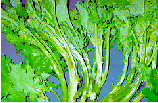 BROCLLI RAAB, also known as Rapini, it has bitter flavor. It may be blanched prior to cooking to take off the bitter edge, if desired. Enjoy steamed, boiled, sautéed, or braised.
BROCLLI RAAB, also known as Rapini, it has bitter flavor. It may be blanched prior to cooking to take off the bitter edge, if desired. Enjoy steamed, boiled, sautéed, or braised.
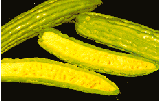 BITTERMELON, this melon, as its name implies, is a touch of bitter. It can be used sliced and sautéed, deep-fried and stir-fried. The golden yellow seed core is most often removed before cooking.
BITTERMELON, this melon, as its name implies, is a touch of bitter. It can be used sliced and sautéed, deep-fried and stir-fried. The golden yellow seed core is most often removed before cooking.
 CARDOON, this vegetable of ancient origin is mostly used by Italian and French chefs. The flavor is that of artichoke and celery. Pre cooking and draining removes most of its inherit bitterness. Enjoy sliced cordoni braised, deep-fried or in soup.
CARDOON, this vegetable of ancient origin is mostly used by Italian and French chefs. The flavor is that of artichoke and celery. Pre cooking and draining removes most of its inherit bitterness. Enjoy sliced cordoni braised, deep-fried or in soup. 
 CELERY ROOT, also known as Celeriac. Although related to the celery often seen in our produce department this version of celery is grown for its roots. The stalks can be added to soups and stews if strong celery flavor ids desired. The root may be peeled and used in salads, soups, stuffing. Celery root can be made to a cream of celery soup.
CELERY ROOT, also known as Celeriac. Although related to the celery often seen in our produce department this version of celery is grown for its roots. The stalks can be added to soups and stews if strong celery flavor ids desired. The root may be peeled and used in salads, soups, stuffing. Celery root can be made to a cream of celery soup.
 CACTUS LEAVES, an interesting edible to say the least, the cactus leaf combines the flavor of green beans, bell pepper and asparagus with unique bite of its own. After de-thorning, the cactus may be boiled, steamed or sautéed. Very versatile, cactus diced or sliced work well in omelets, salsas, deep fried or combined with tomatoes, garlic and cilantro as a vegetable dish.
CACTUS LEAVES, an interesting edible to say the least, the cactus leaf combines the flavor of green beans, bell pepper and asparagus with unique bite of its own. After de-thorning, the cactus may be boiled, steamed or sautéed. Very versatile, cactus diced or sliced work well in omelets, salsas, deep fried or combined with tomatoes, garlic and cilantro as a vegetable dish.
 CHAYOTE SQUASH, this squash blends flavors of turnip, cucumber, and zucchini. Entirely edible, the chaoyte can be sliced and sautéed or deep-fried. Steamed chayote can be added to soup or diced in to salads.
CHAYOTE SQUASH, this squash blends flavors of turnip, cucumber, and zucchini. Entirely edible, the chaoyte can be sliced and sautéed or deep-fried. Steamed chayote can be added to soup or diced in to salads.
 CILANTRO, also known as Chinese parsley and coriander. Cilantro is the characteristic flavor in Latin cooking as well as many oriental favorites. Use entire leaf and stem for this very clean and distinct flavor. Use fresh on tacos, in salsas, stir-fry and relishes.
CILANTRO, also known as Chinese parsley and coriander. Cilantro is the characteristic flavor in Latin cooking as well as many oriental favorites. Use entire leaf and stem for this very clean and distinct flavor. Use fresh on tacos, in salsas, stir-fry and relishes.
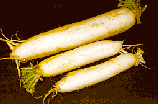 DAIKON, this large, thin-skinned radish has a smooth, sweet and mild bite. It has many uses as it can be peeled then shredded, sliced, for stir-fry, cubed for soups and stews. Often pickled also.
DAIKON, this large, thin-skinned radish has a smooth, sweet and mild bite. It has many uses as it can be peeled then shredded, sliced, for stir-fry, cubed for soups and stews. Often pickled also.
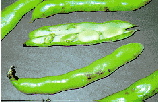 FAVA BEANS, this bean is 6-8 inch long with soft, green outer shell. The entire bean can be eaten if harvested when the bean is only 2-3 inch long. Most favas should be shelled prior to eating. Raw or cooked, the fava has a pungent taste.
FAVA BEANS, this bean is 6-8 inch long with soft, green outer shell. The entire bean can be eaten if harvested when the bean is only 2-3 inch long. Most favas should be shelled prior to eating. Raw or cooked, the fava has a pungent taste. 
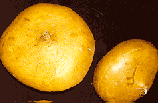 JICAMA, once peeled ivory colored meat is revealed. The meat is juicy and crunchy, similar to waterchestnut. Jicama's flavor is sweet, a touch starchy and although bland. Wonderful when served raw, it may also be stir-fried, baked or sautéed.
JICAMA, once peeled ivory colored meat is revealed. The meat is juicy and crunchy, similar to waterchestnut. Jicama's flavor is sweet, a touch starchy and although bland. Wonderful when served raw, it may also be stir-fried, baked or sautéed.
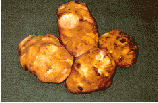 JERUSALEM ARTICHOKES, also know as sunchokes, these brown, and potato like roots are a relative of the sunflower. They can be peeled if desired before eating. The flesh is off white. The sunchoke's flavor has an earthly flavor with hints of artichoke. Enjoy raw, roasted, boiled or steamed.
JERUSALEM ARTICHOKES, also know as sunchokes, these brown, and potato like roots are a relative of the sunflower. They can be peeled if desired before eating. The flesh is off white. The sunchoke's flavor has an earthly flavor with hints of artichoke. Enjoy raw, roasted, boiled or steamed.
 KALE, is a large, hardy, curly leafed green vegetable. It has mild bitter taste. Dark green kale is the best. Kale can be used raw, steamed, stir-fried and in salads. If used raw it is exceptionally rich in vitamin C.
KALE, is a large, hardy, curly leafed green vegetable. It has mild bitter taste. Dark green kale is the best. Kale can be used raw, steamed, stir-fried and in salads. If used raw it is exceptionally rich in vitamin C.
 MUSTARD GREENS, has a pungent flavor. The young leaves can be used in salads. Mustard greens can be used cooked, steamed or as a garnish. If used raw it is exceptionally rich in vitamin C.
MUSTARD GREENS, has a pungent flavor. The young leaves can be used in salads. Mustard greens can be used cooked, steamed or as a garnish. If used raw it is exceptionally rich in vitamin C.
Comments | BACK TO HOME PAGE | SIGN MY GUEST BOOK















